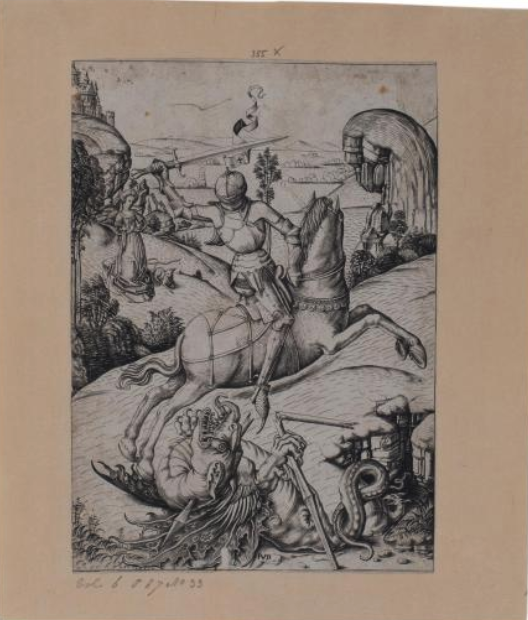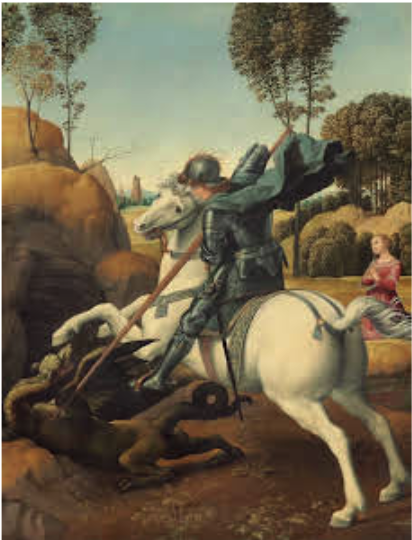Everybody Loves George
A town in trouble! A damsel in distress! A dragon! A knight in shining armor! Who doesn’t love a story that keeps us on the edge of our seats and ends with good conquering evil? Throughout the centuries stories like the myth of St George have been passed down through art and literature as a way to personify gallantry, bravery and honor.
Throughout the centuries, George was a pretty popular subject. Rubens, Raphael, Altdorfer and Uccelo all painted him slaying the dragon. And then there are all the works by unidentified artists. TMA has three of them. In addition to our familiar French painting in Gallery 15, a print from a Flemish engraver who is only known as Master FVP, and a small French ivory sculpture from the mid 1800s are currently not on display. In Gallery 29, Samuel F.B. Morse’s 1827 History Painting, Scene from Spenser’s Faerie Queene depicts a scene in which the Red Cross Knight, (St George), is missing in action but his armor with his red cross is left behind.
But who is George...really? Like many celebrities, there is a distinction between the man and the myth. The man was born in the late third century AD in Cappadocia, (present day Turkey), and moved to Palestine as a child. He was not a knight but most likely a roman soldier. He met his untimely death in 303 AD when he was executed for refusing to make a sacrifice to a pagan god. His reputation as a man of virtue and holiness led to his canonization as a saint almost 200 years after his death.
The myth is a bit more fantastical. Centuries later in 1260 Jacobus de Voragine wrote a book entitled The Golden Legend which was a compendium of the lives of saints. More than 200 years later, thanks to the invention of the printing press, The Golden Legend was mass produced and became quite a popular story book. De Voragine’s accounting of St George spread throughout Europe and George’s status as a saint was elevated for the ages.
In the Golden Legend, George is a knight who saves a town from a fierce dragon who is eating their children. At the moment the dragon is set to eat the king’s daughter, George kills him. The town, in it’s exuberance over this turn of events, follows George’s example and converts to Christianity. In the illiterate society of the late middle ages, this attention grabbing story was a blockbuster with a moral message.
To this day, St George is still making his mark. He is the patron saint of many countries and cities including England, Portugal, Catalonia and Venice. He has been called upon to protect populations from plagues and leprosy and to guide troops in battle. The St George Cross is awarded to citizens of the UK who have shown extraordinary bravery under extenuating circumstances. His flag is the flag of London, but sadly there is controversy as of late as far right organizations are accused of using it as a symbol of exclusivism.
Clearly St George has had his moments throughout the ages. From early Christian martyr to dragon slaying knight, from storybook hero to patron saint, it’s no wonder everybody loves George.
St George and the Dragon
Master FVP
Medium:
Engraving
1 of 11 known prints
About: 1480-490
TMA 1987.169
St George and the Dragon
About: 1480-1490
Medium: Oil on wood P
Painting
TMA 1943.30
St George and the Dragon
Raphael
1505
Oil Painting
Photo credit: National Gallery of Art, Washington DC
St. George and the Dragon
About 1850 - 1870
Medium:
Ivory
Sculpture
TMA 1969.296
Scene from Spenser’s “Fairie Queene”:
Una and the Dwarf
Samuel F. B. Morse
1827
Oil on wood
Painting
TMA 1951.295
St George and the Dragon
Peter Paul Ruebens
1606-08
Oil on canvas
Museo del Prado
Photo credit: Museo del Prado






